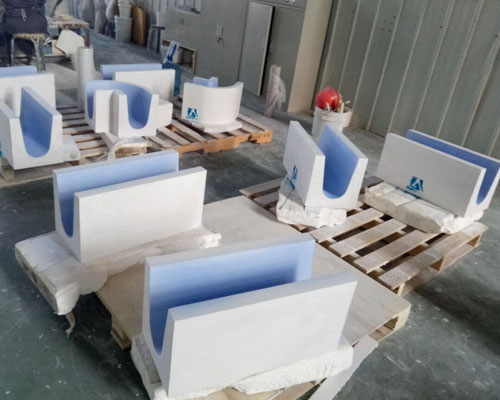The molten aluminum trough is an important part of any foundry shop. Well-designed launders facilitate smooth and efficient foundry operations, where fast transfer between furnaces is essential. Clean, low-turbulence runners play an important role in the production of high-quality products.
Due to the intermittent supply of aluminum, molten aluminum launders often suffer from thermal fatigue cracks. The casting temperature of molten aluminum is about 680°C. When the high-temperature molten aluminum passes through the molten aluminum flow launder, its working surface rises rapidly due to the heat conduction temperature.
Since the wall thickness of the aluminum launder is 4mm×5mm, there is a temperature gradient in the thickness direction of the flow channel, and the expansion of the material in the high temperature region is limited, and compressive stress will be generated.
When the high-temperature aluminum liquid passes through the molten aluminum launder, the temperature of the working surface drops rapidly, and there is still a temperature gradient in the thickness direction of the runner, which results in inconsistent deformation of the runner material.

The shrinkage of the material in the low-temperature region is limited and tensile stress will be generated. Periodic alternating stress will cause thermal fatigue cracks on the working surface, and as the number of thermal cycles increases, the cracks will further expand, eventually leading to the rupture of the flow cell, and the molten aluminum will become uneven. Flows into the pressure chamber, so the die casting process cannot be completed.
At the same time, there are two factors that will accelerate the thermal fatigue damage of the molten aluminum launder. First of all, during use, the oxidation of the launder is very serious, the formation and shedding of surface oxide scale, and the material oxidation on both sides of the crack and the tip material increases the brittleness of the material.
After the molten aluminum infiltrated into the crack is solidified and oxidized, it is equivalent to embedding high-hardness impurities in the material, thus accelerating the propagation speed of the crack. The damage and destruction of the aluminum molten pool will seriously endanger the safety of production equipment and operators.
At present, the widely used protection method is to BN paint the working surface of the molten aluminum launder and trough to prevent heat and corrosion. However, this kind of coating is difficult to withstand the erosion of high-temperature molten aluminum and will quickly lose its protective effect.

